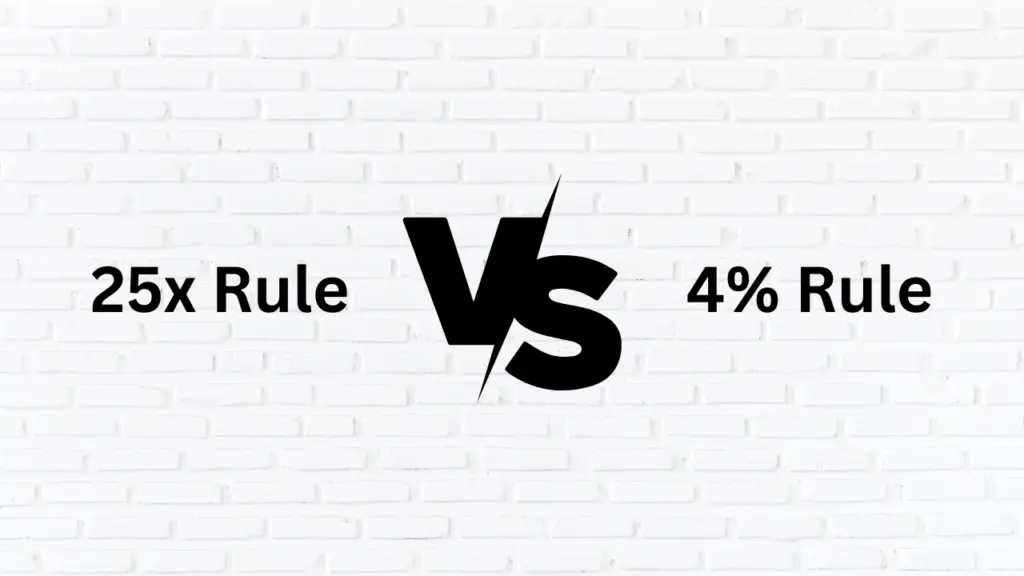Are you looking for a rule of thumb to help you figure out how much money you need to be saved for retirement? If so, you may have heard of the 25x Rule.
This rule states that you should aim to have 25 times your annual living expenses saved by the time you retire. While there are no guarantees regarding retirement planning, the rule of 25 is a good starting point for most people.
This article will discuss the rule, how it works, and why it can be a helpful guideline for retirement savings. So, if you’re curious about the rule of 25, read on!
This post may contain affiliate links; please see our disclaimer for details.

Table of Contents
What Is the 25x Rule for Retirement?
The 25x rule for retirement is a guideline that suggests you should aim to have 25 times your annual cost of living saved. This method is from the financial planning community and is based on the idea that you will need to have enough money saved to withdraw approximately four percent of your nest egg each year.
The rule provides a general guideline for how much you should have saved. It is not meant to be an exact formula but a starting point for your retirement planning.
The number 25 is used because it is believed to be a safe withdrawal rate at 4%. This should leave you with 30 years’ worth of income to cover your costs in retirement.
This percentage is based on historical data and research on retirement planning. The average annual return from the stock market is around 10.5%, but this number can fluctuate.
So, with a 4% withdrawal rate, you would have a greater chance of not running out of money in retirement. That’s even factoring in the possibility of the stock market taking a downturn.
Withdrawing four percent of your nest egg each year should give you enough money to cover your living costs. It also allows your savings to last for at least 25 years in retirement; pretty cool right?
Most people retire at 65, so the 25x Rule is meant to make your money last throughout your retirement.
How Does The Rule of 25 Work?
The way the rule of 25 works is pretty simple. You take the age you plan to retire and multiply it by your current annual salary.
Let’s say you want to retire at 65 and make $50,000 per year. To live comfortably, you will need 25 x $50,000 = $1,250,000 annually.
The rule of 25 is a guideline to help you know how much money you should have saved for retirement by the time you reach a certain age. This would give you 40 years to save for retirement if you started saving at 25.
However, this rule of thumb doesn’t work for everyone. Several factors can affect how much money you will need in retirement. Some examples are lifestyle, health, and whether you plan to retire early.
If you want to retire at 55 instead of 65, you will need to save more money. You would have a shorter time frame to save for retirement. Thus, you would also need to account that you may live longer in retirement than someone who retires at 65.
You may also need to save more money if you have a more lavish lifestyle. A giant nest egg is needed to cover your costs in retirement.
Health is another factor to consider. If you have good health, you may need less money in retirement than someone with health issues. You would have more money to cover other costs with fewer medical bills.
The rule of 25 is a helpful guideline, but it’s essential to remember your circumstances. Having this clear picture of your situation will affect how much money you need to save.
It works (most of the time), but some variables can change the amount of money you need to save.
Why the 25x Rule Works (Most of the Time)
The main reason why the 25x rule works is that it’s based on a very solid foundation: the basic principles of saving and investing.
When you save money, you’re essentially putting your money into a “pot” that you can use later down the road.
The same principle applies to investing. When you invest your money, you’re essentially putting your money into a “pot” that will grow over time.
The goal of saving and investing is to grow your pot of money so you can eventually use it for something important, like retirement. We personally love index funds since they minimize risk and, historically speaking, have performed well with an average increase.
I wrote a separate article going over our Top 2022 IRA Investments. Feel free to check it out!
Now, the reason why the 25x rule works most of the time is that it takes into account two very important factors: inflation and investment returns.
Inflation is the natural tendency for prices to go up over time. This is why groceries and gas cost a little bit more each year.
Investment returns are the money that you earn from investing your money.
For example, if you invest $100 in stock and it goes up by $20, your investment return would be 20%. The 25x rule considers both of these factors when calculating how much money you need to save for retirement.
It doesn’t sometimes work because the inflation rate can increase or decrease over time, and the same goes for investment returns.
If inflation increases faster than expected or investment returns are lower than expected, you may need to save more than 25x your annual expenses.
It can be challenging to predict what inflation and investment returns will be like in the future, which is why the 25x rule is just a guideline and not an exact science.
As we mentioned earlier, other factors such as your lifestyle, health, and retirement age can also affect how much money you need to save.
It’s always important to remember that your circumstances will ultimately determine how much money you need to save for retirement. That’s why the 25x rule is just a guideline, not a hard-and-fast rule.
The Rule of 25 vs. the 4% Rule: What’s the Difference?

The 4% rule indicates that you can withdraw 4% from your retirement and expect that the returns from your investment will surpass the withdrawal rate.
The problem is that with inflation added to this equation, the purchasing power of your money will decrease over time. This means that if you withdraw 4% and the inflation rate was at 8% last year, you’re withdrawing 12% in purchasing power.
If the growth of your investment were less than 12% last year, then you would have to begin dipping into your principle, which is not ideal. This is where the multiply-by-25 rule comes in.
The rule of 25, on the other hand, is a general guideline that suggests you multiply your total salary by 25 to determine how much money you need to save for retirement.
This rule of thumb assumes that you will want to replace your current income via investments during retirement.
It also factors in an estimated annual return of around 10.5% but is used for calculating how much total principle you’d need for retirement. It helps to build a mental framework for those pursuing financial freedom.
The 4% rule calculates how much you can withdraw from your principal after the 25x rule is put into place.
For example, first, you would use the 25 rule to calculate how much you need to have saved. Then, the four percent rule would tell you how much you can withdraw from that savings account each year. The 25x rule is a good starting point, but the 4% helps ensure you don’t outlive your money.
Effective wealth management is imperative to discovering your financial freedom. That’s why we highly recommend PERSONAL CAPITAL.
They offer free financial tools and many resources to help you achieve your financial goals! See how you can better understand and manage your money today!
In Conclusion
The rule of 25 can be a helpful way to estimate how much money you need to save for retirement. Remember it is a guideline and to be flexible when creating your own financial plan.
Everyone’s retirement savings needs are different and will depend on factors such as your desired lifestyle in retirement and how long you expect to live.
If you’re unsure how much money you’ll need in retirement, several online calculators can help you estimate your specific retirement savings needs.
When saving for retirement, the earlier you start, the better. So, if you haven’t started saving, now is the time!
The sooner you start saving, the more time your money will have to grow, and the less you’ll have to save each month.
If you’re already saving for retirement, stay on track to reach your goals by regularly reviewing your savings plan. This will help you ensure you’re still on track and make any necessary adjustments to ensure you have enough money saved when it’s time to retire.\
As always, thank you so much for reading. We’d love to hear your thoughts in the comments section below!
Disclaimer:
We hope the information in this article provides valuable insights to every reader but we, the Biesingers, are not financial advisors. When making your personal finance decisions, research multiple sources and/or receive advice from a licensed professional. As always, we wish you the best in your pursuit of financial independence!

